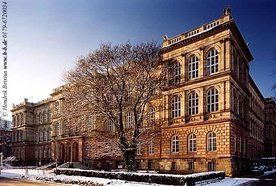RWTH Aachen
|
|
The RWTH Aachen University is a large university located in Aachen (Germany). "RWTH" is the abbreviation of "Rheinisch-Westfälische Technische Hochschule" which loosely means Rhine-Westphalian Institute of Technology. However officially, "RWTH" remains untranslated.
Its main focus are technological studies, especially electrical and mechanical engineering.
| Contents |
Campus
The RWTH is not a campus university. Instead, its buildings are spread over the whole city. There are two core areas (midtown and Melaten district), though not very distinct. The Main Building and the Kármán Hall are 500 m away from the city centre with the Aachen Cathedral, the Audimax (biggest lecture hall) and the main refectory are 200 m farther.
The RWTH has external facilities in Jülich and owns together with the University of Stuttgart a house in Kleinwalsertal in the Austrian Alps.
Organisation
The RWTH Aachen is run by the federal state of North Rhine-Westphalia. There are tuition fees only for long-term students and second studies. Almost all lectures are given in German language, some graduate programs are offered in English.
The RWTH is divided into nine faculties:
| 1 | mathematics, computer science, and natural sciences |
| 2 | architecture |
| 3 | civil engineering |
| 4 | mechanical engineering |
| 5 | geological resources and material sciences |
| 6 | electrical engineering and information technology |
| 7 | philosophy (actually all humanities) |
| 8 | economic sciences |
| 10 | medicines (including the Klinikum Aachen) |
Faculty nine was pedagogical sciences and abandoned in 1989.
The RWTH is a member of the IDEA League.
Students
Today there are approx. 26,000 students at RWTH Aachen, graduate as well as post-graduate, however the number has been rather variable.
Approx. 16% of the students come from other countries, most of them from China, Russia, Morocco, Greece, Spain, Iran, and the Netherlands.
Annually 2000 students graduate and 800 receive their PhD.
Faculty
There are 260 institutes with chairs, and 372 additional lecturers. The scientific staff consists of 6,600 people.
History
In 1870 the "Royal Rhine-Westphalian Polytechnical School of Aachen" was founded. Its primary purpose was to educate engineers for the mining industry in the Ruhr area. At its beginning there were 32 teachers and 223 students.
In 1880 it became a "Technical University" and was abbreviated "RWTH". In 1899 it was granted the right to bestow PhD's.
World War I was a serious setback for the university, but between 1925 and 1932 was a period of prosperity and expansion. Previous student numbers were reached again and many new facilities were built.
During the Third Reich (1933–1945) the RWTH was – like all other institutions – assimilated by the Nazis: The freedom of research and teaching was limited, leading lecturers were forced to quit and many students had to leave the university. Due to the vicinity of the borders to the Netherlands and Belgium the university was closed for a year during World War II.
After the war the RWTH recovered and expanded very quickly. Some new faculties have come into existence.
In 1995 the RWTH was haunted by Third Reich history again. It turned out that the previous rector "Hans Schwerte" (rector for the short duration of 1970 - 1973) had a fake identity. In reality he was Hans Ernst Schneider, an SS member who had worked for the Ahnenerbe. Ironically "Hans Schwerte" had a reputation as a liberal. His pension rights, academic title, etc. were revoked Summary of the events, in German (http://www.archiv.rwth-aachen.de/rea/Seite/biographien_rekt_schwerte.htm).
The RWTH Aachen University, the TU Munich, and the TU Berlin are the three biggest universities for technical studies in Germany.
External links
- RWTH Aachen (http://www.rwth-aachen.de/) (English version available)
de:RWTH Aachen fr:Université technique de Rhénanie-Westphalie à Aix-la-Chapelle

